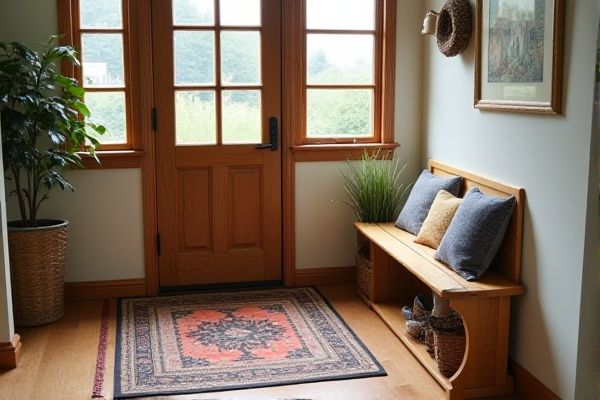
A mudroom rug typically offers larger, more absorbent coverage designed to handle heavy foot traffic and trap dirt, while a doormat is smaller, primarily serving as a quick wipe-off spot at the entrance. Understanding the differences can help you choose the best option to keep Your floors clean and protected--read on to explore which is right for your home.
Table of Comparison
| Feature | Mudroom Rug | Doormat |
|---|---|---|
| Primary Use | Indoor area to trap dirt and moisture | Outdoor area to scrape off dirt from shoes |
| Material | Soft fabrics, often washable | Durable materials like coir, rubber, or synthetic fibers |
| Size | Larger, fits mudroom floor space | Smaller, fits doorstep or entryway |
| Functionality | Absorbs moisture, adds comfort and style | Scrapes off dirt, provides slip resistance |
| Placement | Inside the home, near entry | Outside the door or immediately inside |
| Maintenance | Machine washable or easy to clean | Shake out, hose down, or brush off |
| Durability | Moderate, designed for moderate foot traffic | High, withstands outdoor elements |
Introduction to Mudroom Rugs and Doormats
Mudroom rugs and doormats serve distinct functions in home entryways, with mudroom rugs providing larger, more absorbent surfaces designed to handle heavy foot traffic and outdoor debris. Doormats are typically smaller, placed directly outside or inside the door to trap dirt and moisture from shoes before entering the home. Selecting the right option depends on factors such as durability, material absorption, and the specific needs of your entryway space.
Key Differences Between Mudroom Rugs and Doormats
Mudroom rugs typically cover larger areas, offering enhanced comfort and style while absorbing dirt and moisture from multiple feet, unlike doormats designed for small entry points primarily to scrape off debris. Mudroom rugs are often thicker, more durable, and designed to withstand heavy foot traffic and larger debris loads, whereas doormats tend to be thinner, focused on outdoor use, and often feature coarse textures for immediate dirt removal. The fabric composition and size differences between mudroom rugs and doormats directly influence their functionality and maintenance requirements.
Material Comparison: Durability and Maintenance
Mudroom rugs typically feature durable materials like heavy-duty nylon or polypropylene designed to withstand high traffic and resist stains, making maintenance easier with regular vacuuming and occasional deep cleaning. Doormats are often made from coir or rubber, excels in scraping dirt off shoes but can wear down faster outdoors and require shaking out or hosing off to maintain cleanliness. Choosing the right option depends on your home's entryway needs, balancing durability with ease of upkeep.
Size and Shape: Choosing the Right Fit
Mudroom rugs typically offer larger sizes and rectangular or runner shapes to cover extensive floor space and protect against dirt and moisture. Doormats are smaller, often rectangular or semicircular, designed to fit just outside or inside the door for quick shoe wiping. Selecting your mudroom rug or doormat based on size and shape ensures optimal coverage and functionality tailored to your entryway's layout.
Style and Aesthetic Appeal
Mudroom rugs offer enhanced style and aesthetic appeal with a variety of patterns, textures, and colors that complement interior decor, providing a cozy and inviting look. Doormats typically prioritize functionality and durability, often featuring simple designs and coarse materials for dirt trapping. Choosing a mudroom rug allows for a more harmonious blend with home interiors, while doormats emphasize practicality at entry points.
Functionality: Dirt Trapping and Moisture Control
Mudroom rugs offer superior dirt trapping and moisture control compared to traditional doormats due to their larger size and absorbent materials, effectively capturing more debris and wetness from shoes. Designed for high-traffic transitional spaces, mudroom rugs often feature durable fibers and non-slip backings that withstand heavy use while preventing water damage to floors. Doormats serve as the first line of defense, scraping off surface dirt but typically lack the capacity to manage moisture and dirt accumulation in indoor environments.
Comfort and Cushioning Features
Mudroom rugs offer superior comfort and cushioning compared to standard doormats, featuring thicker padding and softer materials that provide extended support underfoot. Their enhanced absorbency and plush texture make them ideal for standing on for longer periods, reducing fatigue and adding warmth to your entryway. Your mudroom rug not only protects floors but also creates a cozy, inviting space with its comfortable cushioning qualities.
Placement and Practical Uses
Mudroom rugs are typically larger and designed to cover a substantial floor area inside entryways, providing a durable surface for wiping off dirt and moisture from shoes, which protects flooring and reduces cleaning efforts. Doormats, usually smaller and placed just outside or inside the door, primarily serve to catch debris before entering the home, minimizing dirt tracking. Effective placement of mudroom rugs includes high-traffic zones within the mudroom, while doormats belong directly at exterior door thresholds for optimal dirt containment.
Cost and Value Considerations
Mudroom rugs typically cost more than doormats due to larger size and enhanced durability features designed for high foot traffic and moisture control. Investing in a mudroom rug offers long-term value by protecting floors and providing a comfortable, decorative element that withstands heavy use. Doormats, while cheaper, offer limited coverage and durability, making them a cost-effective option for minimal entryway protection.
Which is Best for Your Home: Mudroom Rug or Doormat?
Mudroom rugs offer larger, more durable surfaces designed to handle heavy foot traffic and trap dirt and moisture before it spreads through your home. Doormats serve as smaller first-line barriers, primarily intended for wiping shoes at entryways but may not provide sufficient coverage for cleaning muddy boots or wet shoes. Choosing the best option depends on your home's traffic level and climate, with mudroom rugs being ideal for high-activity areas and doormats suitable for lighter use.
 homyna.com
homyna.com